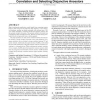1021 search results - page 24 / 205 » On the correlation of binary sequences |
113
click to vote
SADM
2010
14 years 7 months ago
2010
: The traditional latent class analysis (LCA) uses a mixture model with binary responses on each subject that are independent conditional on cluster membership. However, in many pr...
141
click to vote
CIKM
2005
Springer
15 years 6 months ago
2005
Springer
Many bioinformatics applications would benefit from comparing proteins based on their biological role rather than their sequence. In most biological databases, proteins are alrea...
RECOMB
1999
Springer
15 years 4 months ago
1999
Springer
An important goal in bioinformatics is determining the homology and function of proteins from their sequences. Pairwise sequence similarity algorithms are often employed for this ...
92
Voted
BMCBI
2006
15 years 15 days ago
2006
Background: Microarrays measure the binding of nucleotide sequences to a set of sequence specific probes. This information is combined with annotation specifying the relationship ...
80
Voted
DMTCS
2007
15 years 12 days ago
2007
A binary sequence of zeros and ones is called a (d, k)-sequence if it does not contain runs of zeros of length either less than d or greater than k, where d and k are arbitrary, b...

